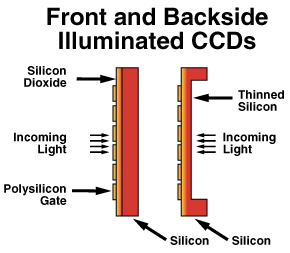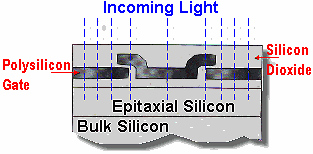

Quantum efficiency is the measure of the effectiveness of an imager to produce
electronic charge from incident photons. This is an especially important property
when doing low-light-level imaging. Because most CCD imagers are made from silicon,
it is useful to examine the properties of this element and the way in which
it interacts with light.
In the high purity crystalline form, each atom of silicon is covalently bonded to its neighbor. Energy greater than the band gap energy, about 1.1 eV, is required to break a bond and create an electron hole pair. The wavelength of incoming light and photon absorption depth are directly related; the shorter the wavelength, the shorter the penetration depth into the silicon.
Light normally enters the CCD through gates of the parallel register (front-illuminated CCD). These gates are made of very thin polysilicon, which is reasonably transparent at long wavelengths, but becomes opaque at wavelengths shorter than 400 nm. Thus, at short wavelengths, gate structure attenuates incoming light.
Back-illuminated CCDs
It is possible, using acid-etching techniques, to uniformly
thin a CCD to a thickness of approximately 10 µm and focus
an image on the backside of the CCD register where there is no
gate structure (back-illuminated CCD). Thinned CCDs exhibit high
sensitivity to light from the soft x-ray to the near-infrared
regions of the spectrum. To improve sensitivity of CCDs in the
blue visible and ultraviolet wavelengths (200 nm - 400 nm), it
is also possible to coat a CCD with Metachrome® II, a proprietary
phosphor developed by Photometrics and Unichrome, a coating optimized
for back-illuminated CCDs developed by Princeton Instruments.
ITO, A new Technology improves Blue/Green
Sensitivity of Frontside-Illuminated CCDs
In an effort to boost the sensitivity of frontside-illuminated
CCDs in the blue/green region of the spectrum, the Eastman Kodak
Company has pioneered a new gate structure based on indium tin
oxide (ITO). Indium tin oxide was a logical candidate for a new
gate material, as it has been used for many years to provide a
clear conductive coating in a wide variety of applications. Kodak's
Microelectronics Technology Division has developed a new fabrication
process that produces gates that are more transparent to light.
Based on indium tin oxide, these gates provide higher light throughput
into the photoconversion layer of the CCD. The resultant imaging
devices have higher QE levels than those attainable with conventional
frontside-illuminated CCDs. This improvement extends across the
visible spectrum, including the blue/green region.
 The quantum efficiency of ITO imagers in the blue/green
region exceeds the QE performance generally seen in lens-on-chip and open-electrode
designs. Furthermore, ITO devices have no inherent reduction of dynamic range
and carry a fairly comparable price tag. All three of these designs are outperformed
by backside-illuminated CCDs in terms of quantum efficiency, but as was pointed
out earlier, price and availability may be the largest issues when considering
thinned devices. Overall, ITO technology represents an excellent " price
and performance" option for many low-light-level applications that require
imaging in the blue/green.
The quantum efficiency of ITO imagers in the blue/green
region exceeds the QE performance generally seen in lens-on-chip and open-electrode
designs. Furthermore, ITO devices have no inherent reduction of dynamic range
and carry a fairly comparable price tag. All three of these designs are outperformed
by backside-illuminated CCDs in terms of quantum efficiency, but as was pointed
out earlier, price and availability may be the largest issues when considering
thinned devices. Overall, ITO technology represents an excellent " price
and performance" option for many low-light-level applications that require
imaging in the blue/green.